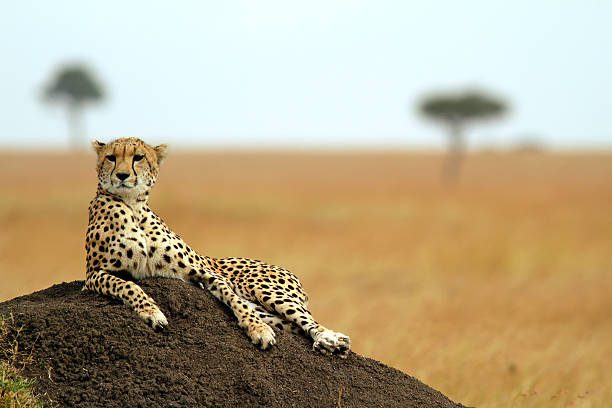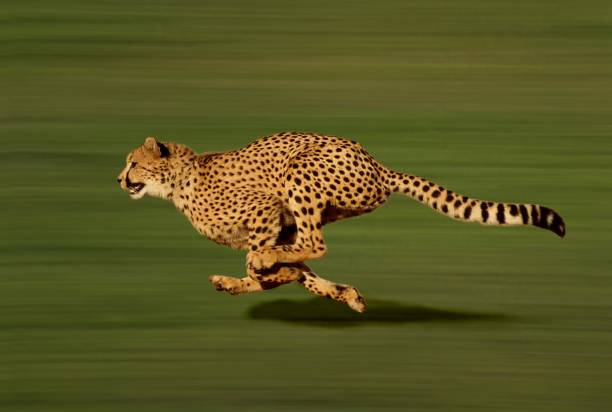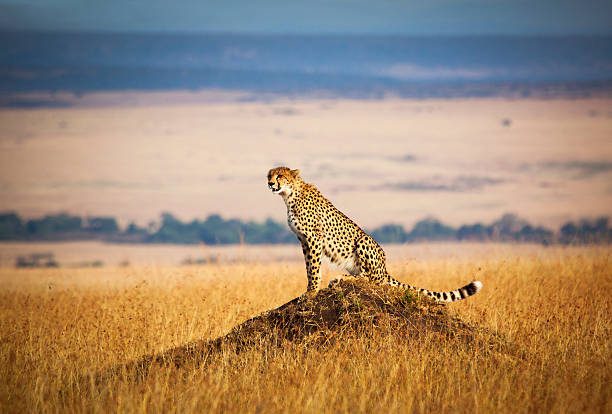The cheetah is a magnificent wild cat known for its incredible speed and grace. Found mostly in Africa and parts of Asia, this unique animal is built for speed, making it one of nature’s most fascinating creatures. Cheetahs are not just fast; they are also agile, intelligent, and adapted perfectly to their environment.
Below, we explore different aspects of the cheetah, from its physical features to its hunting skills and the challenges it faces in the wild.

1. Physical Features
Cheetahs are medium-sized cats, smaller than lions or leopards, but their bodies are built for speed. They can grow up to 3 feet tall at the shoulder and weigh between 75 to 140 pounds. Their slender bodies, long legs, and flexible spines make them perfect for running.
One of their most distinct features is their spotted coat, which helps them blend into their surroundings. They also have black tear-like markings running down their faces, which reduce glare from the sun and improve their focus when hunting. Their long tails help them maintain balance while running at high speeds.
2. Fastest Animal on Land
The cheetah holds the title of the fastest land animal, capable of running up to 70 miles per hour (113 kilometers per hour). However, they can only maintain this speed for short distances, usually around 20 to 30 seconds.
Cheetahs accelerate faster than most cars, reaching 60 miles per hour (96 kilometers per hour) in just three seconds! Their speed, combined with their sharp eyesight, makes them excellent hunters.
3. Hunting Skills
Cheetahs are carnivores, meaning they eat meat. They mainly hunt small to medium-sized animals like gazelles, impalas, and hares. Their hunting strategy involves stalking their prey, getting as close as possible without being noticed, and then launching a high-speed chase to catch it.
Unlike lions, cheetahs hunt during the day, which helps them avoid competition with larger predators. After catching their prey, they eat quickly to avoid losing it to scavengers like hyenas.

4. Habitat and Range
Cheetahs live in open grasslands, savannas, and deserts where there is plenty of space to run and hunt. Most cheetahs are found in Africa, particularly in countries like Namibia, Botswana, and Kenya. A small population also lives in Iran, though they are critically endangered there.
5. Family Life
Cheetahs are solitary animals, meaning they prefer to live alone. However, mothers stay with their cubs for about 18 months, teaching them how to hunt and survive. Male cheetahs sometimes form small groups called coalitions, usually made up of brothers from the same litter.
Cheetah cubs are born with a fluffy gray coat that helps them blend into the tall grass. This protects them from predators like lions, leopards, and hyenas.
6. Threats to Cheetahs
Despite their incredible abilities, cheetahs face many challenges. Habitat loss, caused by farming and human development, is one of the biggest threats. They are also hunted illegally for their fur or captured for the exotic pet trade.
Additionally, cheetahs compete with other predators for food, and their cubs are often at risk from lions and hyenas. As a result, cheetah populations have declined significantly, and they are now classified as vulnerable by conservation groups.
7. Conservation Efforts
Many organizations are working to protect cheetahs and their habitats. Conservation programs focus on protecting wild spaces, reducing human-wildlife conflict, and raising awareness about the importance of cheetahs in ecosystems.
Some reserves and national parks in Africa have been established to give cheetahs a safe place to live and hunt. Efforts are also being made to reintroduce cheetahs into areas where they have disappeared.
8. Why Cheetahs Are Important
Cheetahs play an essential role in maintaining balance in their ecosystems. By hunting prey animals, they help control herbivore populations, preventing overgrazing of vegetation. Their presence also indicates a healthy and balanced environment.

Conclusion
The cheetah is a remarkable animal, admired for its speed, beauty, and role in nature. However, they face many challenges and need our help to survive. Protecting cheetahs and their habitats ensures not only their survival but also the health of the ecosystems they call home. By learning more about cheetahs and supporting conservation efforts, we can help protect these incredible creatures for future generations.

